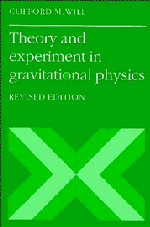Book contents
- Frontmatter
- Contents
- Preface to Revised Edition
- Preface to First Edition
- 1 Introduction
- 2 The Einstein Equivalence Principle and the Foundations of Gravitation Theory
- 3 Gravitation as a Geometric Phenomenon
- 4 The Parametrized Post-Newtonian Formalism
- 5 Post-Newtonian Limits of Alternative Metric Theories of Gravity
- 6 Equations of Motion in the PPN Formalism
- 7 The Classical Tests
- 8 Tests of the Strong Equivalence Principle
- 9 Other Tests of Post-Newtonian Gravity
- 10 Gravitational Radiation as a Tool for Testing Relativistic Gravity
- 11 Structure and Motion of Compact Objects in Alternative Theories of Gravity
- 12 The Binary Pulsar
- 13 Cosmological Tests
- 14 An Update
- References
- References to Chapter 14
- Index
3 - Gravitation as a Geometric Phenomenon
Published online by Cambridge University Press: 04 April 2011
- Frontmatter
- Contents
- Preface to Revised Edition
- Preface to First Edition
- 1 Introduction
- 2 The Einstein Equivalence Principle and the Foundations of Gravitation Theory
- 3 Gravitation as a Geometric Phenomenon
- 4 The Parametrized Post-Newtonian Formalism
- 5 Post-Newtonian Limits of Alternative Metric Theories of Gravity
- 6 Equations of Motion in the PPN Formalism
- 7 The Classical Tests
- 8 Tests of the Strong Equivalence Principle
- 9 Other Tests of Post-Newtonian Gravity
- 10 Gravitational Radiation as a Tool for Testing Relativistic Gravity
- 11 Structure and Motion of Compact Objects in Alternative Theories of Gravity
- 12 The Binary Pulsar
- 13 Cosmological Tests
- 14 An Update
- References
- References to Chapter 14
- Index
Summary
The overwhelming empirical evidence supporting the Einstein Equivalence Principle, discussed in the previous chapter, has convinced many theorists that only metric theories of gravity have a hope of being completely viable. Even the most carefully formulated nonmetric theory – the Belinfante – Swihart theory – was found to be in conflict with the Moscow Eötvös experiment. Therefore, here, and for the remainder of this book, we shall turn our attention exclusively to metric theories of gravity.
In Section 3.1, we review the concept of universal coupling, first defined in Section 2.5. Armed with EEP and universal coupling, we then develop, in Section 3.2, the mathematical equations that describe the behavior of matter and nongravitational fields in curved spacetime. Every metric theory of gravity possesses these equations.
Metric theories of gravity differ from each other in the number and type of additional gravitational fields they introduce and in the field equations that determine their structure and evolution; nevertheless, the only field that couples directly to matter is the metric itself. In Section 3.3, we discuss general features of metric theories of gravity, and present an additional principle, the Strong Equivalence Principle that is useful for classifying theories and for analyzing experiments.
Universal Coupling
The validity of the Einstein Equivalence Principle requires that every nongravitational field or particle should couple to the same symmetric, second rank tensor field of signature –2.
- Type
- Chapter
- Information
- Theory and Experiment in Gravitational Physics , pp. 67 - 85Publisher: Cambridge University PressPrint publication year: 1993

